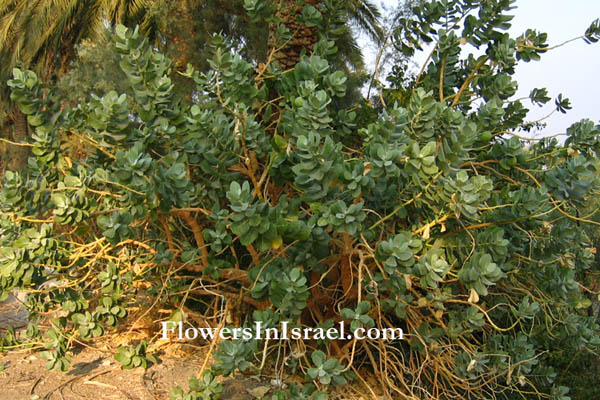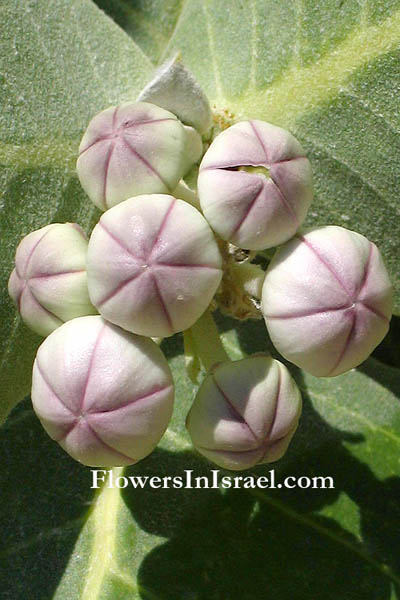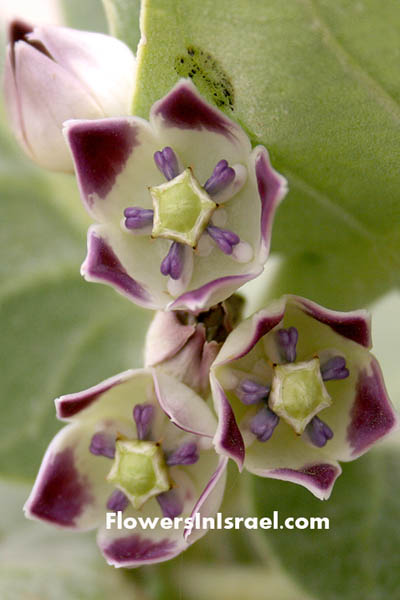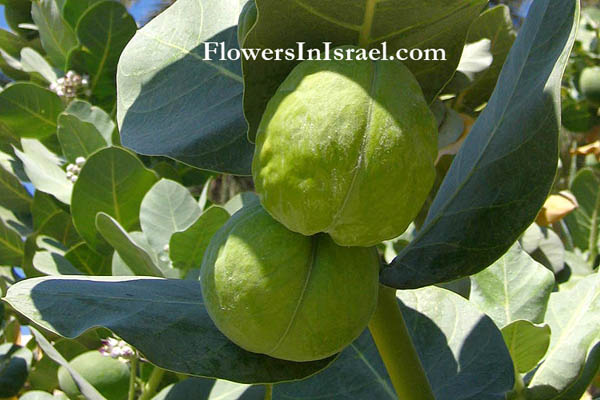Rooster Tree, Rubber Bush, Swallow-Wort,
Hebrew: פתילת-מדבר גדולה, Arabic: العشار
| Scientific name: | Calotropis procera (Aiton) Aiton fil. | |
| Common name: | Sodom's Apple, Dead Sea Apple, Rooster Tree, Rubber Bush, Swallow-Wort | |
| Hebrew name: | פתילת-מדבר גדולה | |
| Arabic name: | العشار | |
| Plant Family: | Asclepiadaceae, אסקלפיים |

Location: Ein Gedi |
| Life form: | Tree | |
| Stems: | 240-300 cm; trunk and branches are covered with thick, cracked bark | |
| Leaves: | Opposite | |
| Flowers: | White. pink | |
| Fruits / pods: | 10-12 cm, balloon-like, globose to ovoid; producing a milky exudate when cut; seeds winged, very numerous, each about 8-10 x 5 mm, attached by broad shiny, white funicles; testa clothed in short, erect, white hairs | |
| Flowering Period: | May, June, July, August, September, October, November | |
| Habitat: | Thermophilous (heat-loving) plants | |
| Distribution: | Mediterranean Woodlands and Shrublands, Semi-steppe shrublands, Shrub-steppes, Deserts and extreme deserts | |
| Chorotype: | Sudanian | |
| Summer shedding: | Perennating |

Location: Ein Gedi Derivation of the botanical name: Calotropiscalos, καλοϛ, beautiful, lovely, pretty; tropis, τρόπις, the keel of a boat, alluding to the shape of showy scales in the flowers. procera, the Latin pro, meaning "for" or "in favour of", and cera (Greek keros), wax, and refers to the waxy appearance of the plant.
Josephus Flavius (37-c.100 CE, born as Joseph Ben Matthias), the Jewish historian living in the Roman period, was the first to mention the so-called Sodom-apple. He describes the destruction of Sodom, which was wiped of the map by God as punishment for the evil ways or its inhabitants (Genesis 18:16-20:29). Josephus mentions that in his day the remains of the destruction can still be seen: 'shadows of the cities are still to be seen, as well as the ashes growing in their fruits, which fruits have a colour as if they were fit to be eaten, but if you pluck them with your hands they dissolve into smoke and ashes.'(Josephus, Jewish Wars, Book IV,8:4). Edward Robinson (1794-1863), who traveled in Palestine in 1838, wrote in his book Biblical Researches in Palestine and Adjacent Countries: "The fruit resembles externally a large, smooth apple, or orange, hanging in clusters of three or four together, and when ripe is of a yellow color. It was now fair and delicious to the eye and soft to the touch; but on being pressed or struck, it explodes with a puff, like a bladder or puff-ball, leaving in the hand only the shreds of the thin rind and a few fibers. It is indeed filled chiefly with air, which gives it the round form; while in the center a small slender pod runs through it which contains a small quantity of fine silk, which the Arabs collect and twist into matches for their guns." Medicinally, the acrid sap latex is used to treat boils, infected wounds and other skin problems in people, and to treat parasitic skin infestations in animals. [The cheese-makers in Benin, country located in western Africa (formerly called Dahomey) use the sap from Calotropis procera as the agent to curdle milk.] It also yields ash for making gunpowder, and extremely strong fiber, which may not be used as wicks for the Sabbath lamps as mentioned in the Mishna (Shabbat 2:1, 'Bemeh madlikin'). See the list of Medicinal herbs in Israel, the parts used and their medical uses to treat various diseases. Bible resources:

Location: Ein Gedi 
Location: Ein Gedi |